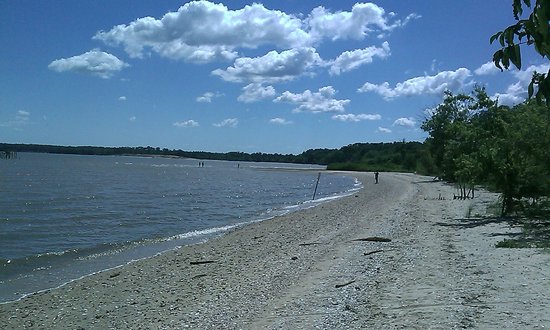One of the most restful places on
Chippokes Plantation in Surry, Virginia,
is an isolated stretch of the James River beach.
The James River becomes a tidal river after it passes through Richmond, Virginia,
so it has many oceanic sea shells and saltwater.
The James River becomes a tidal river after it passes through Richmond, Virginia,
so it has many oceanic sea shells and saltwater.
Not many people go to this stretch of river beach on Chippokes
because it is only accessible after a long trek through field and forest
and then down a steep lane
because it is only accessible after a long trek through field and forest
and then down a steep lane
which closes into a narrow path covered in plantain and fern.
But the solitude of the beach makes the journey worth it.
But the solitude of the beach makes the journey worth it.

tripadvisor.com
The beach is littered with hundreds and hundreds--even thousands--
of undisturbed sea shells: oyster, clam, and many more mollusks I can't readily identify.
Here are some shells I photographed there last spring:
Here are some shells I photographed there last spring:
Along the beach is a cypress grove
And it is there in the cypress grove that we discovered a peculiar occurrence:
dozens of plastic beads, their once shiny paint stripped clean by the sand and surf.
I'd seen them last year, one or two strands half buried in the sand,
but I hadn't given it much thought.
Then this time we discovered dozens.
Some were floating in the surf, others were protruding from the sand.
Most were interwoven in the cypress roots and branches and knobs.
I picked up several, but left many, many more
that refused to be dislodged from their moorings.
This photo shows several unbroken strands that I salvaged:
I always try to remind myself to appreciate things without possessing them;
but as this small collection shows, I'm not always successful.
Yet I love looking at them and contemplating how so many
entered the water and floated to shore.
It's just one of those little mysteries.
<>
I'd seen them last year, one or two strands half buried in the sand,
but I hadn't given it much thought.
Then this time we discovered dozens.
Some were floating in the surf, others were protruding from the sand.
Most were interwoven in the cypress roots and branches and knobs.
I picked up several, but left many, many more
that refused to be dislodged from their moorings.
This photo shows several unbroken strands that I salvaged:
I always try to remind myself to appreciate things without possessing them;
but as this small collection shows, I'm not always successful.
Yet I love looking at them and contemplating how so many
entered the water and floated to shore.
It's just one of those little mysteries.
<>

.jpg)

No comments:
Post a Comment